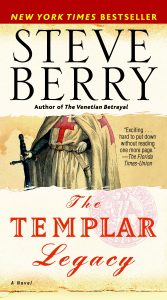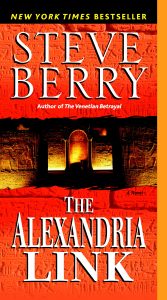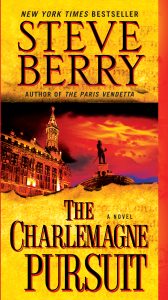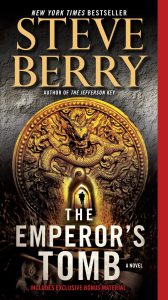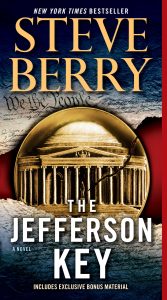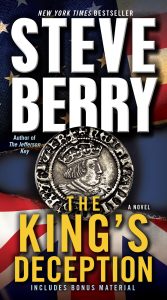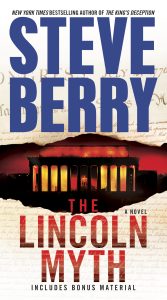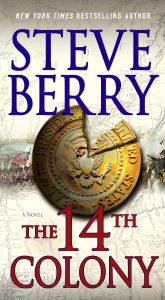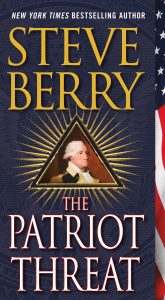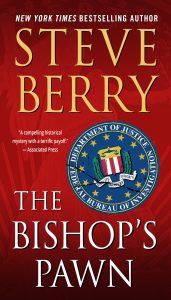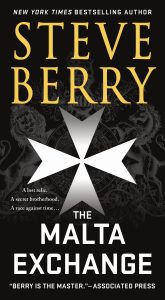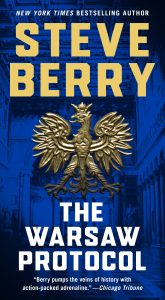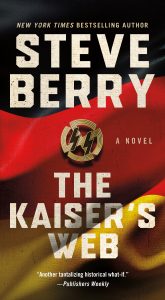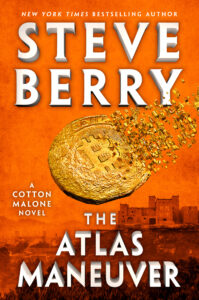The Lost Order
Cotton Malone Series Book 12
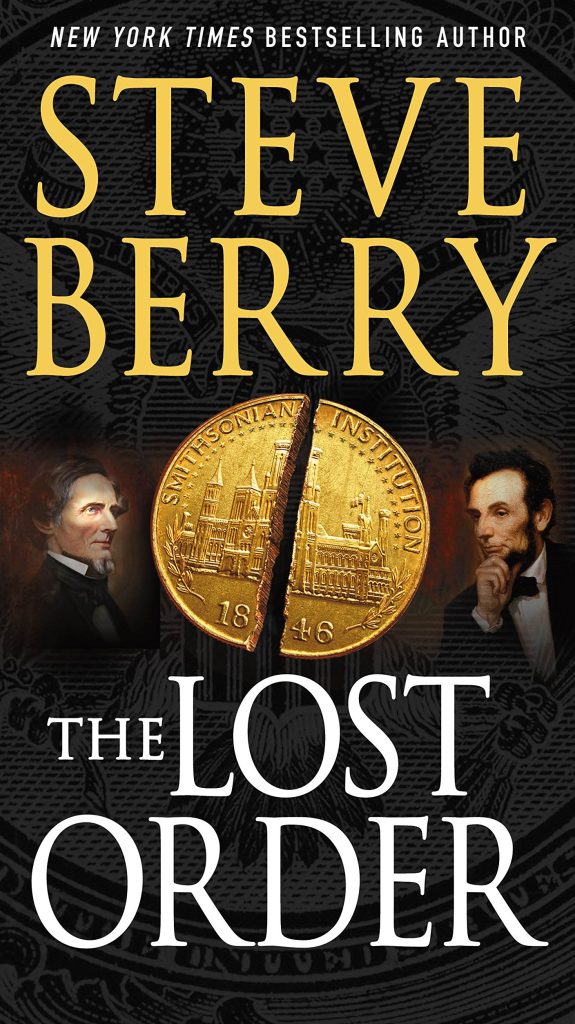 Buy the Book:
Buy the Book:Amazon
Apple Books
Barnes & Noble
IndieBound
Kobo
Audible
Libro.fm
Amazon Canada
Synopsis
Click here to view the trailer for The Lost Order.
The Knights of the Golden Circle was the largest and most dangerous clandestine organization in American history. It amassed billions in stolen gold and silver, all buried in hidden caches across the United States. Since 1865 treasure hunters have searched, but little of that immense wealth has ever been found.
Now, one hundred and sixty years later, two factions of what remains of the Knights of the Golden Circle want that lost treasure—one to spend it for their own ends, the other to preserve it.
Thrust into this battle is former Justice Department agent Cotton Malone, whose connection to the knights is far deeper than he ever imagined. At the center is the Smithsonian Institution—linked to the knights, its treasure, and Malone himself through an ancestor, a Confederate spy named Angus “Cotton” Adams, whose story holds the key to everything. Complicating matters are the political ambitions of a reckless Speaker of the House and the bitter widow of a United States Senator, who together are planning radical changes to the country. And while Malone and Cassiopeia Vitt face the past, ex-president Danny Daniels and Stephanie Nelle confront a new and unexpected challenge, a threat that may cost one of them their life.
From the backrooms of the Smithsonian to the deepest woods in rural Arkansas, and finally up into the rugged mountains of northern New Mexico, The Lost Order is a perilous adventure into our country’s dark past, and a potentially even darker future.
"Steve Berry reminds us of how much fun a book can be with his superb The Lost Order, the latest and maybe best yet in the series featuring his seminal hero Cotton Malone. Indeed, reading Berry makes us feel like a kid again discovering the joy of books. Like Brad Meltzer and James Rollins, he is a master of historical reinvention with a deft hand and keen eye. The Lost Order is a found masterpiece of storytelling genius that is not to be missed.”
— Providence-Journal
"This was fabulous. Steve Berry has been added to my must-read list of authors.”
— The Oklahoman
"Berry has written another gripping novel.”
— Washington Post
"Once again, Berry has delivered an excellent political thriller that weaves fact and fiction, history and the present . . . Cotton Malone is an action hero like no other, and his many fans will eagerly await the latest entry in Berry’s series. A page-turning read that is hard to put down.”
— Library Journal (starred review)
"A fast-paced page-turner, this book has buried treasure, mystery and murder. Berry has hit a grand slam with his latest mystery.”
— Romantic Times Magazine (Top Pick)
"The Lost Order is the latest in the Cotton Malone adventure series, and what an adventure it is. This book is enjoyable on many levels – as a thriller with the code-breaking aspects of The DaVinci Code, as a fascinating account of a dangerous secret society in American history, and as an insider’s romp through the back rooms, tunnels, and hidden places in the Smithsonian Institution. Berry keeps it interesting and relevant while providing a complicated plot with plenty of dangerous players and harrowing situations."
— Top Shelf Magazine
"Narrator Scott Brick's smooth voice flows with the twists and turns of Berry's political thriller as former-Justice Department operative Cotton Malone uncovers a Civil War secret society, stolen gold, and a constitutional crisis in the making.”
— AudioFile Magazine (Audio Earphones Award Winner)
"I found the twists and turns fascinating and thought provoking. This is a real Southern cliffhanger you won’t want to miss. Berry’s book is a good read for hot days when you want to put up your feet and dream, but keep your hands clean.”
— St. Augustine Record
"Yet another thriller penned by Steve Berry. It is a compelling read for those who enjoy thrillers. The action and plot easily keep gripping your attention. Like all other Steve Berry books, this one will also keep you turning pages to the end. A thriller cannot be more entertaining.”
— The Washington Book Review
“Another worthy of the master.”
— Florida Times Union
"Another simply riveting read from a master of the action/adventure genre, The Lost Order is a deftly constructed, multi-layered, consistently compelling novel that deftly showcases author Steve Berry's genuine flair for original and unfailingly entertaining storytelling."
— Midwest Book Review
"The Lost Order, Steve Berry’s latest Cotton Malone adventure, combines the history of a secret society with a look inside the Smithsonian Institution — and it’s terrific.”
— The Daily Press
"History abounds, and Berry proves, yet again, that he has the unique talent to create a maze of facts and fiction that leave readers with a huge smile on their faces. This is most definitely a 5-Star read!”
— Suspense Magazine
"Berry's latest brews another thriller from the formula that's put him on the bestseller lists.”
— Kirkus Reviews
“The prolific Berry has a knack for finding obscure, yet fascinating, historical details and fashioning them into fast-moving novels.”
— Booklist
“Berry delivers exactly what fans of this bestselling series have come to expect — an intricately plotted, action-packed storyline that seamlessly blends history with provocative speculation . . . The fusion of contemporary and historical adventure makes this a page-turner of the highest order."
— Publisher’s Weekly
"I love the Cotton Malone novels. They are not merely dry, historically based dramas filled with copious amounts of arcane facts and figures. In the hands of Steve Berry, this series is infused on every single page with white-knuckle, cliff-hanging thrills that make reading it a pure pleasure. If you happen to learn something new along the way, that is just a nice by-product and personal treasure that makes you wish your childhood history class was even half as exciting as these stories.”
— bookreporter.com
"Cotton Malone’s adventure is another expert melding of nail-biting political intrigue and fascinating historical mystery.”
— Barnes & Noble
FROM THE BLOG WORLD
"Steve Berry once again uses a historical truth to turn out an interesting story. [He] does his research and then fascinates us with ideas most would never come up with. The Lost Order is full of political intrigue, and historical stories, you will find fascinating.”
— Freshfiction.com
"The Lost Order by Steve Berry is a fast read which brings back the familiar characters of Cotton Malone, Cassiopeia Vitt, Danny Daniels and others. True to the author’s style, the story weaves history, intrigue politics and fiction seamlessly. The novel lets the reader know more about Cotton Malone, his ancestor and how he got his nickname. This was a fun book, fast paced, and moved the characters forward.”
— manoflabook.com
“The Lost Order is a fun, fast, and politically timely, book filled with history, treasure hunts, intrigue and murder.”
— tracyreaderdad.com
"Steve Berry masterfully weaves historical fiction into a present day high-concept plot that moves at breakneck speeds from beginning to end. While last year’s The 14th Colony was good, The Lost Order, which falls somewhere between Three Days to the Condor and National Treasure, is Berry’s best work yet–and is sure to compete for best novel of the year. With nonstop action and a story packed full of conspiracies, assassins, power-hungry politicians, murder, and lost treasure, the latest Cotton Malone thriller is impossible to put down.”
— the realbookspy.com
"The prolific Berry has a knack for finding obscure, yet fascinating, historical details and fashioning them into fast-moving novels.”
— booklistonline.com
"As with all Steve Berry novels, this story is based on actual facts and events. He weaves these into a modern day cliff-hanger that keeps the reader glued to the book. The Lost Order is a fun read, and one that also leaves the reader thinking.”
— journalingonpaper.com
"With The Lost Order, Steve Berry shows off his top-notch storytelling skills. This is a mile-a-minute thriller, peppered with historical factoids. It’s fast, furious and fun."
— writtenbysime.com
“The Lost Order,” Steve Berry‘s latest Cotton Malone adventure, combines the history of a secret society with a look inside the Smithsonian Institution – and it‘s terrific. . . . Berry has written another gripping novel.”
— stockdailydish.com
Excerpt
CHAPTER ONE
WESTERN ARKANSAS
TUESDAY, MAY 25
1:06 P.M.
COTTON MALONE FOCUSED ON THE TREASURE.
The hunt had started three hours ago when he’d left a nearby mountain top lodge and been dropped off twenty miles away, on the northern outskirts of the Ouachita National Forest, amid 1.8 million acres of old growth oak, beech, cedar, and elm. The wilderness was a magnet for nature enthusiasts, but 150 years ago it had been the haunt of outlaws, the hilly terrain and dense forests offering excellent hiding places for both loot and people.
He was assisting the National Museum of American History on an assignment that he’d been glad to accept. Usually his old boss Stephanie Nelle either roped him in or outright hired him, but this time the call had come from the Smithsonian chancellor himself, the chief justice of the United States, who explained the problem and provided enough information to pique his interest. The offered $25,000 fee had also been more than generous. Truth be known he would have done it for free, as he had a soft spot for the Smithsonian.
And who didn’t like searching for buried treasure.
The woods that engulfed him stretched from the rugged plateaus of the Ozarks in the north end of the state to the rolling peaks of the Ouachitas in the south. In between lay valleys, overlooks, ridges, caves, and countless rivers and streams. All in all it was a paradise, one he’d never visited before, which was another reason he’d accepted the assignment.
He’d come equipped with 21st century technology, both a magnetometer and a GPS tracker, along with starting coordinates. Using the GPS locator he was threading his way through the trees, approaching a point that, hopefully, a satellite thousands of miles overhead would signal as X-marked-the-spot.
The whole thing was intriguing.
A reference librarian named Martin Thomas, who worked inside the American history museum, had been studying a cache of old maps, notes, and diaries stored in the Smithsonian’s vast archive. The documents were restricted, detailing a Smithsonian investigation conducted in 1909 that had involved a prior expedition to western Arkansas. Nothing had come of that journey, except that its lead researcher had been killed when a couple of hunters mistook him for a deer. It could have been an accident, but Cotton was not naïve enough to think that a locally elected sheriff never looked after his constituents—and rural Arkansas at the turn of the 20th century seemed the precise definition of local.
Easy for things to be swept under the rug.
The GPS locator continued to flash off numbers.
He adjusted his direction and kept walking, searching through the trees. He’d spent the past three days in DC, shuffling through the same field notes, books, papers, maps, and files that had captured Martin Thomas’ attention. His access, though, had come with the chancellor’s blessing. He’d read at length as to what might be expected here on the ground in Arkansas. More recent notes, provided by Thomas himself, described a specific marker—what had been labeled long ago the map tree—along with its precise coordinates. A cooperative concierge at the lodge had told him even more, including the general vicinity of where to find the stately beech.
The locator beeped.
X marked the spot.
And there it was.
The tree stood at least fifty feet tall. Upon it were carved 65 inscriptions. He knew that because Thomas had been here a month ago and counted them. But there’d been an incident. A headless effigy, pockmarked with bullet holes, was suspended over the trail. Strung up from a tree like a lynching, dangling over a pile of spent shotgun shells. Inverted crosses had been painted on the trees all around. A line of string had led from the effigy down to the shells. The message clear.
Go away.
Which had worked.
Thomas had fled.
This time, though, a professional accustomed to trouble had come.
He approached the tree and noticed the carvings. He ran his fingers slowly over a bird, a bell, and what appeared to be a horse with no legs. He’d been told by a botanist at the natural history museum that a beech tree's thin, smooth bark grew slow, preventing cracking. So a mark made on a beech would still be there decades later. Many of the carvings were filled with moss, others warped from decades of growth. But most were legible. He’d brought along a soft nylon brush in his backpack, which he used to gently clear away the lichens, revealing additional letters and symbols. He wanted to study them further, along with their possible interpretations, but they weren’t important at the moment. Instead, taking this as the point of beginning, he searched for another tree.
And saw it.
Ten yards away.
It was a tall red oak, its limbs trimmed long ago into an unnatural pattern, now grown tall like goalposts. He sighted a path past that tree and pointed the GPS. He needed to stay on a straight line, using where he stood as one point and the goalposts as another, keeping the longitudinal GPS number constant, and walking northward, shifting only latitude. He marveled at how, decades ago, this all would have been done by dead reckoning.
He stepped ahead, the underbrush sparse, the trees thick. Sunlight sieved through the leafy spring canopy, dappling the ground. Heat and humidity slid across his sticky skin, heavy as a towel, reminding him of boyhood days in middle Georgia.
A bit shy of twenty yards from the map tree he found a clump of rocks, heavily encrusted with more lichens. He’d been told to keep a lookout for just such a feature. He bent down and examined them, using the brush to clean away a green patina. On one, near the ground line, he found the number 7 chipped into the rock.
Faint. But there.
He lifted the softball-sized stone and turned it over. A quick swipe with the brush and he spotted two letters.
SE.
He’d learned that many markers had been intentionally placed within these woods. There, but not there, so obvious that no one would ever pay them any attention. This clump of rocks seemed the perfect example. Meaningless, unless you were actually paying attention. Something his grandfather once told him came to mind.
“Why hide loot and not have a way to find it?”
Exactly.
The assumption now became that SE meant southeast. The 7? Who knew? Probably just misdirection. Anyone who saw it would never think to turn the rock over. But for someone in the know, who’d come to retrieve whatever had been hidden, the 7 acted as a billboard to draw their attention. He also knew that for the clandestine group who’d supposedly hidden these caches, 7 was a symbolic number. One that said, “The drawbridge is down, the way ahead clear.” All part of their secret, cryptic language.
He switched on the magnetometer. He’d been holding off using it to preserve battery power. He turned southeast, which would take him back toward the map tree, and readied himself. The 1909 field notes had talked of more hidden markers.
An ingenious security system.
Proof positive of human inventiveness.
He hovered the magnetometer just above the ground. The other hand held the GPS locator and he kept on a straight line to the southeast, sweeping the metal detector back and forth. Sixty feet later the instrument buzzed. He laid everything down and found a collapsible shovel in his backpack. Carefully, on his knees, he worked the ground above the find, the soft loamy soil coming away in moist clumps. Six inches down he located a heavily oxidized iron plow point. He knew not to disturb it. Instead, he must learn from it.
He cleared away the dirt and noted the direction the plow pointed.
Southwest.
He marveled that the object was even here. Information within the 1909 field notes had revealed how horseshoes, mule shoes, picks, axe-heads, and, sure enough, plow points had been buried about four to six inches deep. Enough to remain hidden, but not enough to be undetected by a compass needle. Pass a compass over buried iron and the needle will react, much as a paper clip when near a magnet will start to act like a magnet. Martin Thomas had tested the theory while here a month ago with a new plow point and had recorded that it worked. Not nearly as good as a magnetometer, but definitely its great-great-grandfather. Only time had not been factored into the equation. Oxidation degraded magnetic abilities, so it was doubtful a compass would be of any use today. Thank goodness for modern technology.
Expectancy clutched his chest.
This was exciting.
His grandfather would have loved it.
But it was also serious, as a man had died here long ago and Martin Thomas had been terrorized just recently.
So he stayed alert, re-gripped his instruments, and started walking southwest. Sixty more feet and he found another buried marker, this time an axe-head, still pointed southwest. He was careful with both his steps and his digging. This was rattlesnake country, and a few might be out enjoying the toasty afternoon. Which was another reason why his holstered Beretta rested within easy reach inside the backpack.
The vector he’d taken had led straight back to the map tree, forming a large triangle. Now he knew where to concentrate his efforts. No longer was the entire Arkansas countryside in play, only the space between the lines he’d just laid out.
He walked toward its center.
The reflective matte-black lenses of his sunglasses muted the harshness of the bright sun. The branches were full of noise from birds, squirrels, and insects. This part of Arkansas seemed a gorgeous gem tucked away in nearly the center of the country. It was remote a century and a half ago, and not much had changed, the biggest difference being that the National Park Service now made sure everything stayed pristine. He wasn’t exactly sure if he was inside the park boundaries but, if not, he was awful close.
Historically, no substantial quantities of gold had ever been mined in Arkansas, but legends persisted of its existence. And not the kind that came from a clear stream or out of a vein. Instead, it had all been placed. The original hypothesis revolved around 16th-century Spaniards, who’d hidden hundreds of gold caches across the Midwest and West. But outlaws, too, had used these woods as their hideout. Then there was one other group. From the 19th century.
The Knights of the Golden Circle.
Who’d flourished here.
Ahead, nearly in the center of the triangle, he spotted a large maple with a long, vertical line ingrown in its bark.
Hardly noticeable.
Yet there.
He swept the magnetometer over the ground around the tree and it screamed a find. Back to his knees, he dug carefully. Six inches and nothing. He kept going. About a foot down, he felt something hard. An object placed deep enough that no compass would ever find it.
And he knew what that meant.
The prize, gained only after deciphering the other clues and knowing exactly where to dig.
Yes, definitely, this was the property of the Knights of the Golden Circle.
He cleared the soil away and realized that he’d located a glass jar with a metal lid that had long rusted through. He freed the jar, about the size of a half-gallon milk container. Once it was out in the light he saw that it contained a stash of gold coins, packed tight, time doing nearly nothing to dull them. He tried to estimate how many were inside. He’d been told to photograph anything before physically examining it, so he laid the jar on the ground, located his phone, and activated the camera.
He was about to snap a few images when he heard something.
Movement.
Quick.
Approaching.
He reached into his pack, found his Beretta, and pivoted. In a blur of sight and reason, all he caught was a dark figure and the familiar outline of a rifle.
Coming his way.
Then, there was nothing.
Also in this series:
